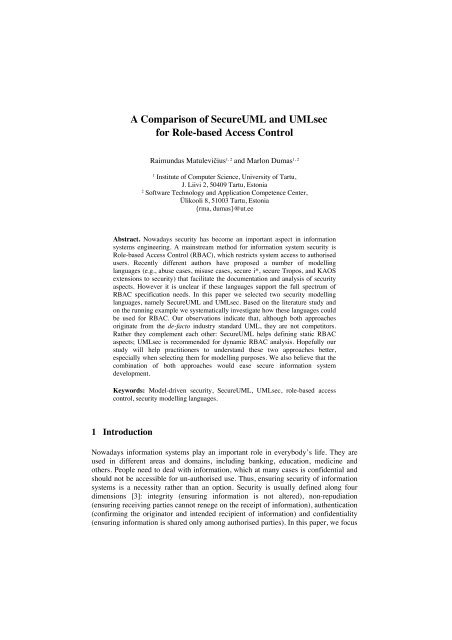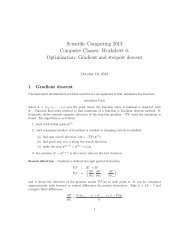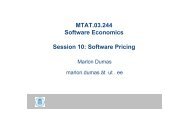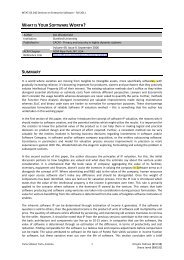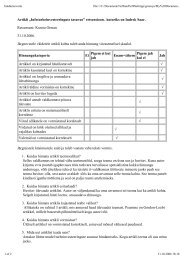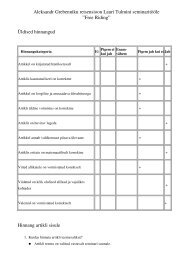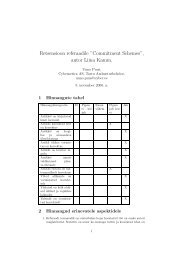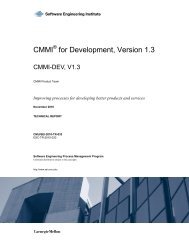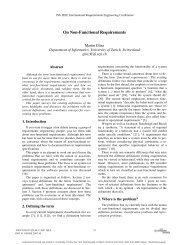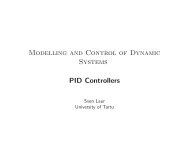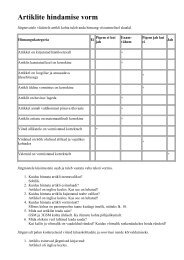A Comparison of SecureUML and UMLsec for Role-based Access ...
A Comparison of SecureUML and UMLsec for Role-based Access ...
A Comparison of SecureUML and UMLsec for Role-based Access ...
You also want an ePaper? Increase the reach of your titles
YUMPU automatically turns print PDFs into web optimized ePapers that Google loves.
A <strong>Comparison</strong> <strong>of</strong> <strong>SecureUML</strong> <strong>and</strong> <strong>UMLsec</strong><br />
<strong>for</strong> <strong>Role</strong>-<strong>based</strong> <strong>Access</strong> Control<br />
Raimundas Matulevičius1, 2 1, 2<br />
<strong>and</strong> Marlon Dumas<br />
1 Institute <strong>of</strong> Computer Science, University <strong>of</strong> Tartu,<br />
J. Liivi 2, 50409 Tartu, Estonia<br />
2 S<strong>of</strong>tware Technology <strong>and</strong> Application Competence Center,<br />
Ülikooli 8, 51003 Tartu, Estonia<br />
{rma, dumas}@ut.ee<br />
Abstract. Nowadays security has become an important aspect in in<strong>for</strong>mation<br />
systems engineering. A mainstream method <strong>for</strong> in<strong>for</strong>mation system security is<br />
<strong>Role</strong>-<strong>based</strong> <strong>Access</strong> Control (RBAC), which restricts system access to authorised<br />
users. Recently different authors have proposed a number <strong>of</strong> modelling<br />
languages (e.g., abuse cases, misuse cases, secure i*, secure Tropos, <strong>and</strong> KAOS<br />
extensions to security) that facilitate the documentation <strong>and</strong> analysis <strong>of</strong> security<br />
aspects. However it is unclear if these languages support the full spectrum <strong>of</strong><br />
RBAC specification needs. In this paper we selected two security modelling<br />
languages, namely <strong>SecureUML</strong> <strong>and</strong> <strong>UMLsec</strong>. Based on the literature study <strong>and</strong><br />
on the running example we systematically investigate how these languages could<br />
be used <strong>for</strong> RBAC. Our observations indicate that, although both approaches<br />
originate from the de-facto industry st<strong>and</strong>ard UML, they are not competitors.<br />
Rather they complement each other: <strong>SecureUML</strong> helps defining static RBAC<br />
aspects; <strong>UMLsec</strong> is recommended <strong>for</strong> dynamic RBAC analysis. Hopefully our<br />
study will help practitioners to underst<strong>and</strong> these two approaches better,<br />
especially when selecting them <strong>for</strong> modelling purposes. We also believe that the<br />
combination <strong>of</strong> both approaches would ease secure in<strong>for</strong>mation system<br />
development.<br />
Keywords: Model-driven security, <strong>SecureUML</strong>, <strong>UMLsec</strong>, role-<strong>based</strong> access<br />
control, security modelling languages.<br />
1 Introduction<br />
Nowadays in<strong>for</strong>mation systems play an important role in everybody’s life. They are<br />
used in different areas <strong>and</strong> domains, including banking, education, medicine <strong>and</strong><br />
others. People need to deal with in<strong>for</strong>mation, which at many cases is confidential <strong>and</strong><br />
should not be accessible <strong>for</strong> un-authorised use. Thus, ensuring security <strong>of</strong> in<strong>for</strong>mation<br />
systems is a necessity rather than an option. Security is usually defined along four<br />
dimensions [3]: integrity (ensuring in<strong>for</strong>mation is not altered), non-repudiation<br />
(ensuring receiving parties cannot renege on the receipt <strong>of</strong> in<strong>for</strong>mation), authentication<br />
(confirming the originator <strong>and</strong> intended recipient <strong>of</strong> in<strong>for</strong>mation) <strong>and</strong> confidentiality<br />
(ensuring in<strong>for</strong>mation is shared only among authorised parties). In this paper, we focus
on the latter dimension <strong>and</strong> specifically, on one mechanism <strong>for</strong> ensuring<br />
confidentiality, namely <strong>Role</strong>-Based <strong>Access</strong> Control (RBAC) that restricts in<strong>for</strong>mation<br />
access to authorised users.<br />
Although security is an important aspect in in<strong>for</strong>mation systems engineering, the<br />
literature [13], [23] reports that security concerns are <strong>of</strong>ten raised only when the<br />
system is about to be deployed or is already in use, or in the best-case security is<br />
considered only during the late system development stages (e.g., implementation). This<br />
is a serious hindrance to secure system development, since the early stages (e.g.,<br />
requirements <strong>and</strong> design) are the place where system security concerns should be<br />
discovered <strong>and</strong> security trade-<strong>of</strong>fs should be analysed. One possible way to guide such<br />
an analysis is suggested by the model-driven security approaches. For instance, Abuse<br />
frames [16] suggest means to consider security during the early phases <strong>of</strong> requirements<br />
engineering. Secure i* [5] addresses security trade-<strong>of</strong>fs. KAOS [15] was augmented<br />
with anti-goal models designed to elicit attackers’ rationales. In [9] Tropos has been<br />
extended with the notions <strong>of</strong> ownership, permission <strong>and</strong> trust. Another version <strong>of</strong><br />
Secure Tropos suggested in [20] models security using security constraints <strong>and</strong> attack<br />
methods. Abuse cases [19], misuse cases [22] <strong>and</strong> mal-activity diagrams [23] address<br />
security concerns through negative scenarios executed by the attacker.<br />
All these modelling approaches could be applied to model RBAC in a system [1],<br />
however they are rather general than specific. In the literature we have observed that<br />
there are two modelling approaches – <strong>SecureUML</strong> [17] <strong>and</strong> <strong>UMLsec</strong> [12] – that,<br />
actually, contain targeted concepts <strong>for</strong> RBAC. Our motivation to look deeper at these<br />
two techniques was also strengthened by the fact that they both originate from UML, a<br />
de facto industry st<strong>and</strong>ard. Thus, we <strong>for</strong>mulated the following research question:<br />
What are the major similarities <strong>and</strong> differences between <strong>SecureUML</strong> <strong>and</strong> <strong>UMLsec</strong><br />
<strong>for</strong> RBAC modelling?<br />
In order to answer this research question we have analysed the <strong>SecureUML</strong> <strong>and</strong><br />
<strong>UMLsec</strong> literature <strong>and</strong> tested both approaches on a Meeting Scheduler example [7].<br />
Our observations are that these approaches are not competitors when it comes to<br />
RBAC modelling, but they rather complement each other with different system<br />
modelling perspectives.<br />
The structure <strong>of</strong> the paper is as follows: in Section 2 we introduce the general<br />
RBAC model <strong>and</strong> two modelling approaches – <strong>SecureUML</strong> <strong>and</strong> <strong>UMLsec</strong>. In Section 3<br />
we compare <strong>SecureUML</strong> <strong>and</strong> <strong>UMLsec</strong>. Section 4 discusses our results <strong>and</strong> situates<br />
them in the state <strong>of</strong> the art. Finally, in Section 5 we conclude our study <strong>and</strong> present<br />
some future work.<br />
2 Background<br />
In this section we present the major artefacts discussed in this paper. Firstly, we recall<br />
the general RBAC model. Next, we present the major principles <strong>of</strong> <strong>SecureUML</strong> <strong>and</strong><br />
<strong>UMLsec</strong>.
2.1 <strong>Role</strong>-<strong>based</strong> <strong>Access</strong> Control<br />
The st<strong>and</strong>ard RBAC model is provided in [8] <strong>and</strong> displayed in Fig. 1. The main<br />
elements <strong>of</strong> this model are Users, <strong>Role</strong>s, Objects, Operations, <strong>and</strong> Permissions. A User<br />
is typically defined as a human being or a s<strong>of</strong>tware agent. A <strong>Role</strong> is a job function<br />
within the context <strong>of</strong> an organisation. <strong>Role</strong> refers to authority <strong>and</strong> responsibility<br />
conferred on the user assigned to this role. Permissions are approvals to per<strong>for</strong>m one or<br />
more Operations on one or more protected Objects. An Operation is an executable<br />
sequence <strong>of</strong> actions that can be initiated by the system entities. An Object is a<br />
protected system resource (or a set <strong>of</strong> resources). Two major relationships in this<br />
model are User assignment <strong>and</strong> Permission assignment. User assignment relationship<br />
describes how users are assigned to their roles. Permission assignment relationship<br />
characterises the set <strong>of</strong> privileges assigned to a <strong>Role</strong>.<br />
2.2 <strong>SecureUML</strong><br />
Fig. 1. <strong>Role</strong>-<strong>based</strong> <strong>Access</strong> Control Model (adapted from [8])<br />
The <strong>SecureUML</strong> meta-model [2], [17] <strong>based</strong> on the RBAC model, is shown in Fig. 2.<br />
It defines the abstract syntax to annotate UML diagrams with in<strong>for</strong>mation pertaining to<br />
access control. The meta-model introduces concepts like User, <strong>Role</strong>, <strong>and</strong> Permission as<br />
well as relationships between them. Protected resources are expressed using the<br />
st<strong>and</strong>ard UML elements (concept <strong>of</strong> ModelElement). In addition ResourseSet<br />
represents a user defined set <strong>of</strong> model elements used to define permissions <strong>and</strong><br />
authorisation constraints.<br />
The semantics <strong>of</strong> Permission is defined through ActionType elements used to<br />
classify permissions. Here every ActionType represents a class <strong>of</strong> security-relevant<br />
operations (e.g., read, change, delete, <strong>and</strong> etc) on a particular type <strong>of</strong> protected<br />
resource. On another h<strong>and</strong> a ResourceType defines all action types available <strong>for</strong> a<br />
particular meta-model type. An AuthorisationConstraint is a part <strong>of</strong> the access control<br />
policy. It expresses a precondition imposed to every call to an operation <strong>of</strong> a particular<br />
resource. This precondition usually depends on the dynamic state <strong>of</strong> the resource, the<br />
current call, or the environment. The authorisation constraint is attached either directly<br />
or indirectly, via permissions, to a particular model element representing a protected<br />
resource. The concrete syntax <strong>of</strong> <strong>SecureUML</strong> is illustrated in Fig. 3 <strong>and</strong> discussed in<br />
Section 3.2.
2.3 <strong>UMLsec</strong><br />
Fig. 2. <strong>SecureUML</strong> meta-model (adapted from [2], [17])<br />
A major purpose <strong>of</strong> security modelling is to define mechanisms to satisfy security<br />
criteria, such as confidentiality <strong>and</strong> integrity [18]. To support this activity UMLSec<br />
[12], [13] is defined as a UML pr<strong>of</strong>ile extension using stereotypes, tagged values <strong>and</strong><br />
constraints (see Table 1). Constraints specify security requirements. Threat<br />
specifications correspond to actions taken by the adversary. Thus, different threat<br />
scenarios can be specified <strong>based</strong> on adversary strengths.<br />
A subset <strong>of</strong> <strong>UMLsec</strong> that is directly relevant to this study are the role-<strong>based</strong> access<br />
control stereotype – – its tagged values <strong>and</strong> constraints [13]. This stereotype<br />
en<strong>for</strong>ces RBAC in the business process specified in the activity diagram. It has three<br />
associated tags {protected}, {role}, <strong>and</strong> {right}. The tag {protected} describes the states<br />
in the activity diagram, the access to whose activities should be protected. The {role}<br />
tag may have as its value a list <strong>of</strong> pairs (actor, role) where actor is an actor in the<br />
activity diagram, <strong>and</strong> role is a role. The tag {right} has as its value a list <strong>of</strong> pairs (role,<br />
right) where role is a role <strong>and</strong> right represents the right to access a protected resource.<br />
The associated constraint requires that the actors in the activity diagram only per<strong>for</strong>m<br />
actions <strong>for</strong> which they have the appropriate rights. The application <strong>of</strong> the <br />
stereotype is illustrated in Section 3.<br />
3 <strong>Comparison</strong><br />
In order to compare <strong>SecureUML</strong> <strong>and</strong> <strong>UMLsec</strong>, firstly, we confront their general<br />
characteristics. Next, using the Meeting scheduler example, we illustrate how<br />
<strong>SecureUML</strong> <strong>and</strong> <strong>UMLsec</strong> could be used to develop RBAC models.
Table 1. <strong>UMLsec</strong> stereotypes (adapted from [12], [13]). The scope <strong>of</strong> this paper is<br />
highlighted in italic<br />
Stereotypes Base class Tags Constraints Description<br />
fair subsysem start, stop, after start eventually en<strong>for</strong>ce fair<br />
exchange<br />
adversary reach stop<br />
exchange<br />
rbac subsystem protected, role, only permitted en<strong>for</strong>ces RBAC<br />
Intenet<br />
encrypted<br />
right<br />
activities executed<br />
link Internet<br />
connection is<br />
encrypted<br />
smart card node smart card node<br />
critical subsystem, secrecy, integrity,<br />
critical object<br />
object authenticity, high,<br />
fresh<br />
data subsystem adversary, provides secrecy, basic data<br />
security<br />
integrity,<br />
integrity,<br />
security<br />
authenticity authenticity,<br />
freshness<br />
constraints<br />
guarded subsystem guarded object access control<br />
access<br />
accessed through using guarded<br />
guards<br />
objects<br />
guarded object guard guarded object<br />
3.1 Literature-<strong>based</strong> <strong>Comparison</strong> <strong>of</strong> <strong>SecureUML</strong> <strong>and</strong> <strong>UMLsec</strong><br />
Our general <strong>SecureUML</strong> <strong>and</strong> <strong>UMLsec</strong> comparison is <strong>based</strong> on the <strong>SecureUML</strong> <strong>and</strong><br />
<strong>UMLsec</strong> literature analysis. The primary sources are [17] <strong>for</strong> <strong>SecureUML</strong> <strong>and</strong> [12] <strong>for</strong><br />
<strong>UMLsec</strong>. We selected these two because they correspond to the “time-stamp” <strong>of</strong> both<br />
approaches: they both are published at the same venue. However, <strong>for</strong> the sake <strong>of</strong><br />
completeness we also consider two other sources: [2] <strong>for</strong> <strong>SecureUML</strong> <strong>and</strong> [13] <strong>for</strong><br />
<strong>UMLsec</strong>. In this section we focus on the language extension mechanism, modelling<br />
targets <strong>and</strong> language application guidance. The results are summarised in Table 2.<br />
Extension mechanism. Both approaches originate from the UML language 1 .<br />
<strong>SecureUML</strong> is developed through the explicit meta-model presented in Section 2. On<br />
another h<strong>and</strong>, <strong>UMLsec</strong> does not have an explicit meta-model, but the general UML<br />
meta-model [21] is implicitly extended with security modelling concerns.<br />
Both <strong>SecureUML</strong> <strong>and</strong> <strong>UMLsec</strong> are proposed as the “lightweight UML extensions”,<br />
namely new stereotypes, tagged values <strong>and</strong> constraints are defined. The difference is in<br />
the stereotype meaning. <strong>SecureUML</strong> is specifically oriented to the terminology <strong>of</strong> the<br />
RBAC model, <strong>and</strong> defines stereotypes, such as , ,<br />
1 We base our analysis on a UML version available at a time [12] <strong>and</strong> [17] were published. With<br />
the development <strong>of</strong> UML 2.x the extension mechanism might be different. For instance UML<br />
2.x does not contain explicit tagged values (these become additional attributes <strong>of</strong> stereotypes).<br />
However we did not observe any major UML changes, that would influence our analysis <strong>of</strong><br />
<strong>SecureUML</strong> <strong>and</strong> <strong>UMLsec</strong>. Our comparison remains relevant independently <strong>of</strong> the UML<br />
version.
, , . This means that<br />
<strong>SecureUML</strong> extends mainly the pr<strong>of</strong>ile <strong>of</strong> the UML class diagrams 2 . <strong>UMLsec</strong> takes a<br />
broader scope. It extends the whole UML pr<strong>of</strong>ile, extending base classes such as model<br />
subsystem, link, node, dependency, <strong>and</strong> object. The extension stereotypes are applied at<br />
different UML diagrams. Hence, here the stereotype is only one extension<br />
<strong>of</strong> the subsystem base class, applied in the activity diagram.<br />
Authorisation constraints in <strong>SecureUML</strong> are written in the object constraint<br />
language (OCL) [24]. In <strong>UMLsec</strong> no specific constraint language is m<strong>and</strong>ated.<br />
Table 2. General comparison <strong>of</strong> <strong>SecureUML</strong> <strong>and</strong> <strong>UMLsec</strong><br />
Criteria <strong>SecureUML</strong> <strong>UMLsec</strong><br />
Extension Meta-model Explicit, <strong>based</strong> on the Not explicit, as the UML<br />
mechanism<br />
RBAC model<br />
pr<strong>of</strong>ile extension<br />
UML pr<strong>of</strong>ile Mainly class diagrams The whole UML pr<strong>of</strong>ile<br />
(use cases, class, activity,<br />
Extension Stereotypes, tagged<br />
state, component, <strong>and</strong> other<br />
diagrams)<br />
Stereotypes, tagged values <strong>and</strong><br />
mechanism values <strong>and</strong> authentication<br />
constraints<br />
constraints<br />
Constraints Written in OCL Constraint language is not<br />
identified<br />
Modelling Security Not identified Confidentiality, integrity,<br />
targets <strong>and</strong> criteria<br />
authenticity <strong>and</strong> other<br />
application Security RBAC RBAC, non-reputation, secure<br />
method requirements<br />
communication link, secrecy<br />
<strong>and</strong> integrity, authenticity,<br />
Method Development <strong>of</strong> the<br />
freshness, secure in<strong>for</strong>mation<br />
flows, <strong>and</strong> guarded access<br />
Not explicit, but implicitly<br />
RBAC models<br />
supports st<strong>and</strong>ard security<br />
management methods<br />
Modelling targets <strong>and</strong> application method. In the security risk management<br />
literature, a security criterion expresses a problem domain by “characterising the<br />
security needs” [18]. Security requirements describe a solution domain by defining a<br />
condition “we wish to make true by installing the system in order to mitigate risks”<br />
[18].<br />
In our study we did not identify how <strong>SecureUML</strong> could model security criteria.<br />
<strong>SecureUML</strong> is basically meant <strong>for</strong> modelling <strong>of</strong> solutions especially through RBAC<br />
models. This results in <strong>SecureUML</strong> application guidelines, basically oriented towards<br />
RBAC development.<br />
2 In [16] authors speak about “host language” that would be he main language to model the<br />
system <strong>and</strong> the s<strong>of</strong>tware itself. However, in the example the <strong>SecureUML</strong> authors primarily<br />
focus on class diagrams as the host language. Although some application <strong>of</strong> <strong>SecureUML</strong><br />
stereotypes are proposed <strong>for</strong> state diagrams [2], the examples are limited <strong>and</strong> do not give much<br />
detail.
<strong>UMLsec</strong> is meant to per<strong>for</strong>m a <strong>for</strong>mal analysis <strong>of</strong> system security. The language<br />
could be applied at both problem <strong>and</strong> solution domains. In a <strong>UMLsec</strong> model, one can<br />
define confidentiality, integrity, <strong>and</strong> authenticity criteria. To satisfy the identified<br />
security criteria, <strong>UMLsec</strong> proposes solution stereotypes, such as security policies <strong>for</strong> a<br />
fair exchange, RBAC, non-repudiation, secure communication link, secrecy <strong>and</strong><br />
integrity, authenticity, freshness, <strong>and</strong> secure in<strong>for</strong>mation flow definitions. The<br />
application <strong>of</strong> <strong>UMLsec</strong> implicitly supports st<strong>and</strong>ard security risk management [4], [6],<br />
[10] that includes secure asset identification, definition <strong>of</strong> security criteria, risk<br />
analysis, <strong>and</strong> security requirements <strong>and</strong> controls definition.<br />
3.2 RBAC Modelling using <strong>SecureUML</strong> <strong>and</strong> <strong>UMLsec</strong><br />
In this section we will consider a well-known Meeting scheduler example [7]. It is<br />
described as follows: Meeting initiator needs to organise a top-secret meeting. He<br />
needs to invite potential Meeting participants <strong>and</strong> find a suitable meeting place <strong>and</strong><br />
time. In order to ease his task Meeting initiator decides to use a Meeting scheduler<br />
system <strong>for</strong> sending invitations, merging availability dates <strong>and</strong> in<strong>for</strong>ming the Meeting<br />
participants. Since the Meeting is top secret, the Meeting scheduler system must apply<br />
appropriate security policy <strong>for</strong> the Meeting agreement (place <strong>and</strong> time). This means,<br />
the time <strong>and</strong> place could be entered <strong>and</strong> changed only by the Meeting initiator <strong>and</strong><br />
could be viewed only by the invited Meeting participants. In other words, no<br />
unintended audience should get access to the Meeting agreement. We will illustrate<br />
how this problem can be modelled with <strong>SecureUML</strong> <strong>and</strong> with <strong>UMLsec</strong>.<br />
<strong>SecureUML</strong>. In Fig. 3 we present a <strong>SecureUML</strong> model to illustrate RBAC policy <strong>for</strong><br />
the Meeting Scheduler System. Here we define three users Bob, Ann <strong>and</strong> John, who<br />
play different roles in the system. We also present that a resource<br />
(MeetingAgreement), which characterise place <strong>and</strong> time <strong>of</strong> the meeting, needs to be<br />
secured. Thus, a certain restriction on changing the state (changing the value <strong>of</strong> the<br />
attributes place <strong>and</strong> time) <strong>of</strong> this resource needs to be defined <strong>for</strong> the role<br />
MeetingInitiator <strong>and</strong> role MeetingParticipant.<br />
Association class InitiatorPermissions characterises two actions allowed <strong>for</strong> the<br />
MeetingInitiator: (i) action enterAgreementDetails (<strong>of</strong> type Insert) defines that<br />
MeetingInitiator can enter time <strong>and</strong> date by executing operation setTimePlace() (see<br />
class MeetingAgreement), <strong>and</strong> (ii) action changeMeetingInfo (<strong>of</strong> type Update) allows<br />
changing place <strong>and</strong> time <strong>of</strong> the MeetingAgreement by executing operation<br />
changeTimePlace() (see class MeetingAgreement). To strengthen these permissions we<br />
define authorisation constraints AC#1 <strong>and</strong> AC#2:<br />
AC#1:<br />
context MeetingAgreement::setTimePlace():void<br />
pre: self.roleInitiator.assignedUser -><br />
exists(i | i.assignedUser = “Bob”)
Fig. 3. Meeting Scheduler with <strong>SecureUML</strong><br />
Authorisation constraint AC#1 means that operation setTimePlace() (<strong>of</strong> class<br />
MeetingAgreement) can be executed (enter time <strong>and</strong> place), by one user Bob assigned<br />
to a role MeetingInitiator 3 . Similarly, the authorisation constraint AC#2 defines<br />
restriction <strong>for</strong> operation changeTimePlace() (<strong>of</strong> class MeetingAgreement):<br />
AC#2:<br />
context MeetingAgreement::changeTimePlace():void<br />
pre: self.roleInitiator.assignedUser -><br />
exists(i|i.assignedUser = “Bob”)<br />
Association class ParticipantPermissions defines a restriction <strong>for</strong> the<br />
MeetingParticipant role. It defines an action getAgreementIn<strong>for</strong>mation (<strong>of</strong> type Select)<br />
that says that only MeetingParticipant can view place <strong>and</strong> time defined in the<br />
MeetingAgreement. To en<strong>for</strong>ce this permission an authorisation constraint AC#3 is<br />
defined:<br />
3 As illustrated in [2] <strong>SecureUML</strong> model might contain both objects (e.g., Bob, Ann, <strong>and</strong> John)<br />
<strong>and</strong> classes (e.g., MeetingInitiator, MeetingParticipant) in the same diagram when defining<br />
user assignment relationship. This results in authorisation constraints AC#1, AC#2 <strong>and</strong> AC#3<br />
being very restrictive <strong>and</strong> allowing only the exact users defined in the model to per<strong>for</strong>m<br />
operations on the secured resource (e.g., MeetingAgreement). In case the user assignment<br />
relationship was not specified, the precondition might be expressed like<br />
self.roleInitiator.assignedUser=caller, where caller is a set <strong>of</strong> users<br />
(assigned to a role) on behalf <strong>of</strong> whom the operation is executed.
AC#3:<br />
context MeetingAgreement::viewTimePlace():void<br />
pre: self.roleParticipant-><br />
exists (p1|p1.assignedUser="Ann") <strong>and</strong><br />
self.roleParticipant-><br />
exists (p2|p2.assignedUser="John") <strong>and</strong><br />
self.roleParticipant->size = 2<br />
Authorisation constraint AC#3 says that only users Ann <strong>and</strong> John who have an<br />
assigned role MeetingParticipant can execute an operation viewTimePlace() (<strong>of</strong> class<br />
MeetingAgreement).<br />
<strong>UMLsec</strong>. Fig. 4 illustrates application <strong>of</strong> <strong>UMLsec</strong> to model the Meeting Scheduler<br />
System. Here we define an activity diagram, which describes an interaction between<br />
MeetingInitiator, MeetingAgreement, <strong>and</strong> MeetingParticipant. The diagram specifies<br />
that MeetingInitiator can insert meeting time <strong>and</strong> date. Next MeetingParticipant is able<br />
to check if the time <strong>and</strong> place are suitable to him. If the agreement is not OK,<br />
MeetingParticipant requests MeetingInitiator to update. After the agreement (time <strong>and</strong><br />
date <strong>of</strong> the meeting) data are updated MeetingParticipant can check them again <strong>for</strong><br />
suitability.<br />
This diagram carries an stereotype, meaning that the security policy<br />
needs to be applied to the protected actions. For instance, the MeetingInitiator’s action<br />
Insert meeting time <strong>and</strong> date leads to the action Set time <strong>and</strong> date <strong>for</strong> the<br />
MeetingAgreement. Set time <strong>and</strong> date is executed if <strong>and</strong> only if there exists an<br />
associated tag, that defines the following: (i) Set time <strong>and</strong> date is a protected action,<br />
(ii) Bob plays a role <strong>of</strong> MeetingInitiator, <strong>and</strong> (iii) MeetingInitiator en<strong>for</strong>ces the action<br />
Set time <strong>and</strong> date. In the activity diagram this associated tag (AT#1) is defined as<br />
follows:<br />
AT#1:<br />
{protected = Set time <strong>and</strong> date}<br />
{role = (Bob, MeetingInitiator)}<br />
{right = (MeetingInitiator, Set time <strong>and</strong> date)}<br />
Similarly, the sets <strong>of</strong> associated tags are defined <strong>for</strong> other two protected actions<br />
View time <strong>and</strong> date (AT#2) <strong>and</strong> Change time <strong>and</strong> date (AT#2). Note that both Ann <strong>and</strong><br />
John can initiate execution <strong>of</strong> action View time <strong>and</strong> date (AT#2), since they both play<br />
the role <strong>of</strong> MeetingParticipant.<br />
AT#2:<br />
{protected = View time <strong>and</strong> date}<br />
{role = ([Ann, John], MeetingParticipant)}<br />
{right = (MeetingParticipant, View time <strong>and</strong> date)}<br />
AT#3:<br />
{protected = Change time <strong>and</strong> date}<br />
{role = (Bob, MeetingInitiator)}<br />
{right = (MeetingInitiator, Change time <strong>and</strong> date)}
Fig. 4. Meeting Scheduler with <strong>UMLsec</strong><br />
<strong>Comparison</strong> <strong>of</strong> modelling constructs. In Table 3 we compare the RBAC modelling<br />
using <strong>SecureUML</strong> <strong>and</strong> <strong>UMLsec</strong>. We base our comparison on the RBAC model [8]<br />
presented in Section 2.1 (see Fig. 1). In this comparison we review which constructs<br />
are used <strong>for</strong> expressing the RBAC concepts <strong>and</strong> relationships. In Table 3 we also<br />
provide construct examples from Fig. 3 <strong>and</strong> Fig. 4.<br />
Firstly, we observe that both approaches cover all RBAC concepts <strong>and</strong><br />
relationships. This means that both approaches can express security policies through<br />
RBAC. Secondly, <strong>SecureUML</strong> addresses RBAC through the defined stereotypes, while<br />
than <strong>UMLsec</strong> expresses RBAC concepts <strong>and</strong> relationships through the associated tags<br />
<strong>and</strong> their values. At the example level, both approaches use the same (e.g., <strong>for</strong> Users,<br />
<strong>Role</strong>s, <strong>and</strong> Objects) or very similar (e.g., <strong>for</strong> Operations) labels <strong>for</strong> the RBAC<br />
concepts.<br />
Some modelling <strong>and</strong> labelling differences are observed when it comes to<br />
relationship definition. In <strong>SecureUML</strong> User assignment relationship is modelled<br />
through a UML-stereotyped dependency without defining any label. In <strong>UMLsec</strong> the<br />
specific associated tag – {role} – is defined <strong>for</strong> a user-to-role assignment. Different<br />
labelling is also used to specify Permission assignments. In <strong>SecureUML</strong> this is done<br />
through stereotyped association classes, which might carry a name depending on the<br />
modelled context. In <strong>UMLsec</strong> the associated tag – {right} – is used <strong>for</strong> this purpose.
Finally, we note, that <strong>UMLsec</strong> does provide explicit means to define Permission<br />
itself. This is rather left implicitly at the diagram level when defining the values <strong>for</strong> all<br />
the associated tags ({protected}, {role}, <strong>and</strong> {right}). In <strong>SecureUML</strong> Permissions are<br />
explicitly defined through authorisation constraints expressed in OCL (see, <strong>for</strong><br />
instance, the preconditions in AC#1, AC#2, <strong>and</strong> AC#3).<br />
Table 3. <strong>Comparison</strong> <strong>of</strong> RBAC modelling using <strong>SecureUML</strong> <strong>and</strong> <strong>UMLsec</strong><br />
RBAC<br />
<strong>SecureUML</strong> <strong>UMLsec</strong><br />
concepts Construct Example Construct Example<br />
Users Class stereotype Bob, Ann, <strong>and</strong> John Actor value <strong>of</strong> “Bob”, “Ann”, <strong>and</strong><br />
(concept) <br />
the associated<br />
tag {role}<br />
“John”<br />
User Dependency Dependency between Associated {role = (Bob,<br />
assignment stereotype classes such as Bob <strong>and</strong> tag {role} MeetingInitiator)}<br />
(relationship) MeetingInitiator, <strong>and</strong><br />
Ann or John <strong>and</strong><br />
{role = ([Ann, John],<br />
MeetingParticipant<br />
MeetingParticipant)}<br />
<strong>Role</strong>s Class stereotype MeetingInitiator <strong>and</strong> <strong>Role</strong> value <strong>of</strong> “MeetingInitiator” <strong>and</strong><br />
(concept) MeetingParticipant the associated<br />
tag {role}<br />
“MeetingParticipant”<br />
Permission<br />
assignment<br />
Association class<br />
stereotype<br />
InitiatorPermissions<br />
<strong>and</strong><br />
Associated<br />
tag {right}<br />
{right = (MeetingInitiator,<br />
Set time <strong>and</strong> date)}<br />
(relationship) <br />
(MeetingParticipant,<br />
View time <strong>and</strong> date)}<br />
{right = (MeetingInitiator,<br />
Change time <strong>and</strong> date)}<br />
Objects Class stereotype MeetingAgreement Activity MeetingAgreement<br />
(concept) <br />
partition<br />
Operations Class operations setTimePlace(), An action Set time <strong>and</strong> date,<br />
(concept)<br />
changeTimePlace(),<br />
View time <strong>and</strong> date, <strong>and</strong><br />
<strong>and</strong> viewTimePlace()<br />
Change time <strong>and</strong> date<br />
Permissions Authorisation AC#1, AC#2, <strong>and</strong> AC#3 All three Not defined explicitely<br />
(concept) constraint<br />
association<br />
tags {role}<br />
{protected},<br />
<strong>and</strong> {right}<br />
4 Discussion <strong>and</strong> Conclusions<br />
In this section, first, we will discuss limitations <strong>of</strong> our comparison. Next, we will see<br />
how our analysis confronts to the results found in the related work.<br />
4.1 Limitations<br />
This study is not without limitations. Firstly, we need to note that our analysis is <strong>of</strong><br />
limited scope, as it is <strong>based</strong> on the literature survey <strong>and</strong> on a simple example (e.g.,<br />
Meeting Scheduler System [7]). It might be the case that if we carried out an extensive
empirical study or a set <strong>of</strong> benchmarking examples we would receive different<br />
comparison results. Secondly, although we followed the theory as close as possible,<br />
our modelling example (in Fig. 3 <strong>and</strong> Fig. 4) carries a certain degree <strong>of</strong> subjectivity<br />
regarding the modelling decisions.<br />
Thirdly, we should note that <strong>for</strong> our analysis we have selected only extracts <strong>of</strong> the<br />
modelling approaches. This is especially true <strong>for</strong> the <strong>UMLsec</strong>, where we focussed only<br />
on the means to define RBAC aspects. In addition to this <strong>UMLsec</strong> also provides other<br />
stereotypes (e.g., <strong>and</strong> ) that are used to deal with<br />
access control policies (without considering role assignments).<br />
In the comparative example we skipped the application <strong>of</strong> <strong>UMLsec</strong> throughout the<br />
security risk management process [4], [6], [10]. For example, in Fig. 4 we could<br />
consider MeetingAgreement actions as assets <strong>and</strong> analyse the security criteria, such as<br />
confidentiality, integrity, <strong>and</strong> availability <strong>of</strong> the meeting agreement. Then, we could<br />
define a new swim-lane, which would illustrate how an attacker could exploit system<br />
vulnerabilities in order to break the security. However, in this paper we specifically<br />
focus on the definition <strong>of</strong> the security solution (through RBAC), because the goal is to<br />
contrast UMLSec with <strong>SecureUML</strong>, <strong>and</strong> the latter does not support security risk<br />
management.<br />
4.2 Related Work<br />
In the literature we identified two surveys [1], [11] that consider different security<br />
modelling approaches [5], [9], [12], [15], [16], [17], [19], [20], [22], [23] <strong>and</strong> their<br />
application <strong>for</strong> the RBAC modelling. In this section we specifically address the<br />
observation about <strong>SecureUML</strong> <strong>and</strong> <strong>UMLsec</strong>.<br />
In [1] the BRAC0 pattern is applied <strong>for</strong> comparison <strong>of</strong> security modelling<br />
approaches. The survey shows that, on one h<strong>and</strong>, <strong>SecureUML</strong> does not explicitly<br />
model security criteria (such as confidentiality, integrity, <strong>and</strong> availability) but it<br />
focuses on modelling the solutions to security problems guided by the RBAC nature.<br />
With <strong>SecureUML</strong>, a modeller can define assets, however, the language does not allow<br />
expressing attacks or harms to the assets. On the other h<strong>and</strong>, <strong>UMLsec</strong> is guided by<br />
security criteria, however it does not have means to model them explicitly. The<br />
<strong>UMLsec</strong> application is driven by analysis <strong>of</strong> system vulnerabilities: (i) once security<br />
vulnerabilities have been identified, the system design is progressively refined to<br />
eliminate the potential threats; (ii) the refinement <strong>of</strong> the design might be continued<br />
until the system satisfies the security criteria. Although <strong>UMLsec</strong> was analysed <strong>based</strong><br />
on the BRAC0 pattern, authors does not specifically indicate how well this approach is<br />
suitable <strong>for</strong> RBAC modelling.<br />
In [11] Jayaram <strong>and</strong> Mathur investigate how the practice <strong>of</strong> s<strong>of</strong>tware engineering<br />
blends with the requirement <strong>of</strong> secure s<strong>of</strong>tware. The work describes a two-dimensional<br />
relationship between the s<strong>of</strong>tware lifecycle stages <strong>and</strong> modelling approaches used to<br />
engineer security requirements. A part <strong>of</strong> the study is dedicated to RBAC modelling<br />
using <strong>SecureUML</strong> <strong>and</strong> <strong>UMLsec</strong>. Authors indicate that <strong>UMLsec</strong> is rather general<br />
approach than specific, thus it cannot be used to model access control policies solely.<br />
On another h<strong>and</strong> <strong>SecureUML</strong> is suggested as the means to specify access control
policies. However <strong>SecureUML</strong> cannot describe protected resources (system design),<br />
thus, it has to be used in conjunction with a base modelling language (e.g.,<br />
ComponentUML).<br />
Results <strong>of</strong> our study support findings <strong>of</strong> both [1] <strong>and</strong> [11]. For instance like in [1]<br />
we also notice the limitation <strong>of</strong> <strong>SecureUML</strong> to indicate security criteria. We also<br />
observe that the <strong>UMLsec</strong> application follows the st<strong>and</strong>ard security modelling methods<br />
(e.g., [4], [6], [10]). However our findings contradict those <strong>of</strong> [11] regarding <strong>UMLsec</strong><br />
support <strong>for</strong> RBAC modelling. We observe that <strong>UMLsec</strong> provides means <strong>for</strong> RBAC<br />
modelling: it helps defining the dynamic characteristics <strong>of</strong> the secure system. Our<br />
analysis suggests that both modelling approaches can complement each other <strong>and</strong><br />
result in more complete specifications <strong>of</strong> secure in<strong>for</strong>mation systems (where both static<br />
<strong>and</strong> dynamic characteristics are defined).<br />
5 Conclusions <strong>and</strong> Future Work<br />
In this paper we have analysed how <strong>SecureUML</strong> <strong>and</strong> <strong>UMLsec</strong> can help defining<br />
security policies through the role-<strong>based</strong> access control mechanism. The contribution <strong>of</strong><br />
this study is tw<strong>of</strong>old. Firstly, a comparison <strong>of</strong> two security modelling languages gives<br />
modellers the criteria to selecting techniques <strong>for</strong> the RBAC analysis. Our major<br />
conclusions include the following:<br />
- We observe that both <strong>SecureUML</strong> <strong>and</strong> <strong>UMLsec</strong> are applicable to model RBAC<br />
solutions. Table 3 illustrates that both approaches have means to address the RBAC<br />
concepts <strong>and</strong> relationships. The strong feature <strong>of</strong> <strong>SecureUML</strong> is the explicit<br />
definition <strong>of</strong> Permissions through authorisation constraints using OCL. On another<br />
h<strong>and</strong> our general comparison showed that at the methodological level <strong>SecureUML</strong><br />
only focus on the solution domain. <strong>UMLsec</strong> provides means to identify <strong>and</strong><br />
consider system risks, determine system vulnerabilities, <strong>and</strong> also develop solutions<br />
(RBAC is one <strong>of</strong> them) to mitigate the identified risks.<br />
- Although both approaches originate from UML, <strong>SecureUML</strong> <strong>and</strong> <strong>UMLsec</strong> focus on<br />
different modelling perspectives to define security policies. <strong>SecureUML</strong> is used to<br />
model static characteristics <strong>of</strong> RBAC, thus, it is applied in the class diagrams.<br />
<strong>UMLsec</strong> is used to model dynamic characteristics <strong>of</strong> RBAC 4 , thus it relies heavily<br />
on activity diagrams. Taking into account that system modelling needs to be<br />
addressed from different modelling perspectives [14], this means that both<br />
approaches are not competitors, but they rather complement each other by<br />
providing different viewpoints to the secure system.<br />
In this paper we did not have a purpose to define model trans<strong>for</strong>mation rules between<br />
these approaches. However, a second part <strong>of</strong> our contribution is a set <strong>of</strong> guidelines (see<br />
Table 3) that could facilitate preparation <strong>of</strong> the RBAC activity diagram (using<br />
<strong>UMLsec</strong>) if we have a defined <strong>SecureUML</strong> class diagram or vice versa (<strong>SecureUML</strong><br />
class diagram if the <strong>UMLsec</strong> activity diagram is done). But we also acknowledge that<br />
these guidelines, currently, should not be taken <strong>for</strong> granted because a further <strong>and</strong> more<br />
4 This is relevant only <strong>for</strong> the <strong>UMLsec</strong> stereotype, other <strong>UMLsec</strong> stereotypes can be<br />
applied at different model types.
fine-grained analysis is necessary in order to define <strong>SecureUML</strong> <strong>and</strong> <strong>UMLsec</strong><br />
trans<strong>for</strong>mation rules <strong>for</strong> RBAC. Such a definition remains <strong>for</strong> future work.<br />
Acknowledgments. This research is funded by Logica <strong>and</strong> the European Regional<br />
Development Funds through the Estonian Competence Centre Programme. The authors<br />
would like to thank Andreas Sisask <strong>and</strong> Henri Lakk from Logica Estonia <strong>for</strong> the<br />
discussions <strong>and</strong> collaboration on this work. We also like to thank the anonymous<br />
reviewers whose comments helped to improve the camera-ready copy <strong>of</strong> this paper.<br />
References<br />
1. B<strong>and</strong>ara, A., Shinpei, H., Jurjens, J., Kaiya, H., Kubo, A., Laney, R., Mouratidis, H.,<br />
Nhlabatsi, A., Nuseibeh, B., Tahara, Y., Tun, T., Washizaki, H., Yoshioka, N., Yu, Y.:<br />
Security Patterns: Comparing Modelling Approaches. Technical Report No 1009/06,<br />
Department <strong>of</strong> Computing Faculty <strong>of</strong> mathematics, Computing Technology, The Open<br />
University (2009)<br />
2. Basin, D., Doser, J., Lodderstedt, T.: Model Driven Security: from UML Models to <strong>Access</strong><br />
Control Infrastructure. ACM Transactions on S<strong>of</strong>tware Engineering <strong>and</strong> Methodology<br />
(TOSEM), 15 (1), 39--91 (2006)<br />
3. Caelli, W., Longley, D., <strong>and</strong> Shain, M.: In<strong>for</strong>mation Security H<strong>and</strong>book. Macmillan<br />
Publishers, 1991.<br />
4. DCSSL. EBIOS - Expression <strong>of</strong> Needs <strong>and</strong> Identification <strong>of</strong> Security Objectives (2004)<br />
5. Elahi, G., Yu, E.: A Goal Oriented Approach <strong>for</strong> Modeling <strong>and</strong> Analyzing Security Trade-<br />
Offs. In: Parent, C., Schewe, K.D., Storey, V.C., Thalheim, B. (eds.) Proceedings <strong>of</strong> the 26th<br />
International Conference on Conceptual Modelling (ER 2007) (2007)<br />
6. ENISA. Inventory <strong>of</strong> Risk Assessment <strong>and</strong> Risk Management Methods (2004)<br />
7. Feather, M.S., Fickas, S., Finkelstein, A., van Lamsweerde A.: Requirements <strong>and</strong><br />
Specification Exemplars. Automated S<strong>of</strong>tware Engineering, 4: 419--438 (1997)<br />
8. Ferraiolo D.F., S<strong>and</strong>hu, R., Gavrila, S., Kuhn, D.R., Ch<strong>and</strong>ramouli, R.: Proposed NIST<br />
St<strong>and</strong>ard <strong>for</strong> <strong>Role</strong>-<strong>based</strong> <strong>Access</strong> Bontrol. ACM Transactions on In<strong>for</strong>mation <strong>and</strong> System<br />
Security (TISSEC), 4(3), 224--274 (2001)<br />
9. Giorgini, P., Massacci, F., Mylopoulos, J., Zannone, N.: Modeling Security Requirements<br />
Through Ownership, Permision <strong>and</strong> Delegation. In: Proceedings <strong>of</strong> the 13th IEEE<br />
International Conference on Requirements Engineering (RE’05), IEEE Computer Society<br />
(2005)<br />
10. ISO. In<strong>for</strong>mation technology - Security techniques - In<strong>for</strong>mation security management<br />
systems - Requirements, International Organisation <strong>for</strong> St<strong>and</strong>ardisation (2005)<br />
11. Jayaram, K.R., Mathur, A.P.: S<strong>of</strong>tware Engineering <strong>for</strong> Secure S<strong>of</strong>tware – State <strong>of</strong> the Art: a<br />
Survey. Technical report CERIAS TR 2005-67, Department <strong>of</strong> Computer Sciences &<br />
CERIAS, Purdue University (2005)<br />
12. Jurjens, J.: <strong>UMLsec</strong>: Exending UML <strong>for</strong> Secure Systems Development. In: Proceedings <strong>of</strong><br />
the 5th International Conference on The Unified Modeling Language, LNCS, vol. 2460, pp.<br />
412--425. Springer-Verlag (2002)<br />
13. Jurjens. J.: Secure Systems Development with UML. Springer-Verlag Berlin Heidelberg,<br />
(2005)<br />
14. Krogstie J., Solvberg A.: In<strong>for</strong>mation Systems Engineering, Conceptual Modeling in a<br />
Quality Perspective. Course compendium, Norwegian University <strong>of</strong> Science <strong>and</strong><br />
Technology, (2000)
15. van Lamsweerde, A.: Elaborating Security Requirements by Construction <strong>of</strong> Intentional<br />
Anti-models. In: Proceedings <strong>of</strong> the 26th International Conference on S<strong>of</strong>tware Engineering<br />
(ICSE’04), IEEE Computer Society pp. 148--157 (2004)<br />
16. Lin, L., Nuseibeh, B., Ince, D., Jackson, M.: Using Abuse Frames to Bound the Scope <strong>of</strong><br />
Security Problems. In: Proceedings <strong>of</strong> the 12th IEEE international Conference on<br />
Requirements Engineering (RE’04), IEEE Computer Society (2004) 354--355<br />
17. Lodderstedt, T., Basin, D., Doser, J.: <strong>SecureUML</strong>: A UML-<strong>based</strong> Modeling Language <strong>for</strong><br />
Model-driven Security. In: Proceedings <strong>of</strong> the 5th International Conference on The Unified<br />
Modeling Language, LNCS, vol. 2460, pp. 426--441. Springer-Verlag (2002)<br />
18. Mayer N.: Model-<strong>based</strong> Management <strong>of</strong> In<strong>for</strong>mation System Security Risk. PhD Thesis,<br />
University <strong>of</strong> Namur (2009)<br />
19. McDermott, J., Fox, C.: Using Abuse Case Models <strong>for</strong> Security Requirements Analysis. In:<br />
Proceedings <strong>of</strong> the 15th Annual Computer Security Applications Conference (ACSAC’99).<br />
55 (1999)<br />
20. Mouratidis, H.: Analysing Security Requirements <strong>of</strong> In<strong>for</strong>mation Systems using Tropos. In:<br />
Proceedings 1st Annual Conference on Advances in Computing <strong>and</strong> Technology (AC&T),<br />
London - United Kingdom, pp. 55--64 (2006)<br />
21. OMG, Unified Modeling Language: Superstructure, version 2.0 (2005)<br />
22. Sindre, G.: Mal-activity Diagrams <strong>for</strong> Capturing Attacks on Business Processes. In:<br />
Proceedings <strong>of</strong> the Working Conference on Requirements Engineering: Foundation <strong>for</strong><br />
S<strong>of</strong>tware Quality (REFSQ 2007), Springer-Verlag Berlin Heidelberg, pp. 355--366 (2007)<br />
23. Sindre, G., Opdahl, A.L.: Eliciting Security Requirements with Misuse Cases. Requirements<br />
Engineering Journal 10(1) pp. 34--44 (2005)<br />
24. Warner, J., Kleippe, A.: The Object Constraint Language, second edition, Getting Your<br />
Models Ready <strong>for</strong> MDA. Addison-Wesley (2003)


